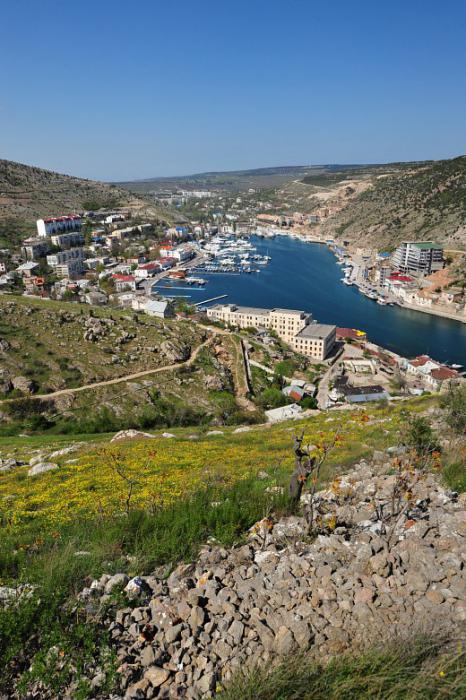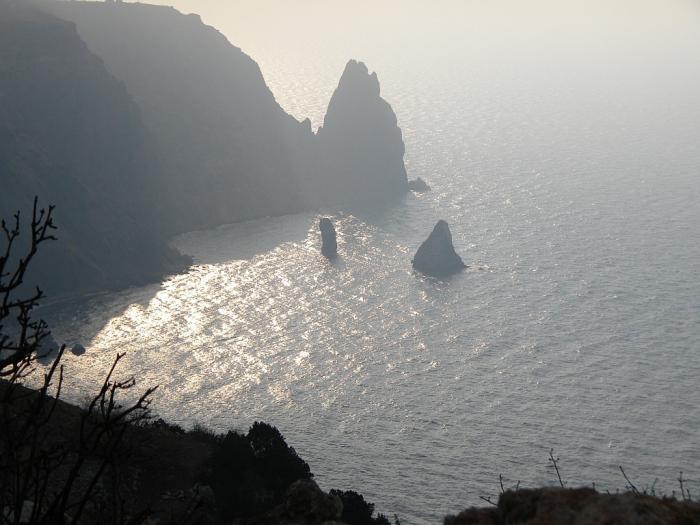The city of Balaklava in the Crimea is a district of Sevastopol, the history of which has more than two and a half thousand years. Despite the fact that it is a small town, many people around the world know it. Streets and metro stations in Europe and America are named by this name. This land keeps the secrets of civilizations, and many times the fate of entire nations was decided on it. Each of the nationalities living on this earth left its mark on it. Genoese - Chembalo fortress, Turks - the name of the bay, the British - the embankment and buildings.

It was this village that Homer described in his Odyssey as the place of residence of the Listrigons, mythical giants. The description of the bay is like no other suitable for the village of Balaklava (Crimea). Many myths of ancient Greece were born here. Roman legionnaires and Tatar nomads managed to leave their mark on the genotype of local residents. And the heroic feat of the Soviet soldiers glorified and forever left Balaklava and Sevastopol in the memory of their descendants. Its real name, which translates as Balyk-Juve ("fish nest"), Balaklava (Crimea) received in 1475, when it was captured by the Turks.
Invisible to enemies from the sea and a harbor full of fish - this is a fertile place people appreciated immediately. Balaklava on the map of Crimea is a long and deep bay. Surrounded by cliffs, since ancient times, it has attracted people as a convenient place to live. Game was found in the forests, mountain streams gave spring water. The first inhabitants of this area to leave their mark on history were the warlike Taurus, then it passed to the Greeks. In the 14th century, the Genoese, who built the Chembalo fortress in 1357, became the owners. And to the present day, perfectly preserved, it serves as a visiting card of the city of Balaklava (Crimea).
Chembalo Fortress
The fortress has the shape of a quadrangle - impregnable walls on three sides, and a steep cliff on the fourth. It is documented that during the devastating earthquake of 1927 in Crimea, when whole rocks collapsed, not a single stone broke off the walls of Cembalo. The greatest damage she received during the Great Patriotic War.
Today you can take a walk to the Fortress Mountain by climbing the stairs from Nazukin embankment. The observation deck, which offers a magnificent view of the entire bay, will make you stop and fix the memorable places of the village (Crimea) Balaklava. The photos will be just wonderful. If you decide to climb to the next towers, you will have to overcome quite steep climbs. But on the other hand, one can very well imagine how the defenders of the fortress climbed such a road 700 years ago.
Chembalo Fortress is currently a branch of the Tauric Chersonesos Nature Reserve. Excavations are ongoing throughout the territory. Thanks to them, it turned out that initially it was a two-tier city: people lived in the lower one, the upper one was administrative. In the upper city, St. Nicholas, in a square 15-meter tower, there was a consul castle, a temple and a town hall. A water supply from a nearby mountain was even made here. In the lower city, in addition to houses with residents, there were shops of merchants, workshops and a shipyard. The city was well protected: in addition to high walls, a huge chain stretched between the towers blocked the entrance to the bay.
When the fortress was captured by the Turks, they began to use it as a military garrison and prison, where they contained objectionable Crimean khans. After the annexation of Crimea to Russia, the fortress was no longer used. During the Crimean and World War II, the walls served as defensive structures.
Embankment in Balaclava
In the Crimean War, Balaclava became an English military base, and the embankment itself was built by the British. They laid the first railway in the Crimea, a telegraph. It was then that they began to call the harbor “Little London”. Before the revolution, the embankment was called English. During the time of Tsarist Russia, wealthy aristocrats built their summer cottages on it, in particular, the princes Yusupov and Gagarin. Some of the buildings have survived to this day.
The most ancient fortress
In the village of Balaklava (Crimea), on Rubtsova street, 43, there is a medieval church of 12 apostles, the oldest in the Crimea. This is evidenced by a tablet found during the reconstruction period. On it is the date of commencement of construction - 1357. The temple is majestic and simple at the same time - only columns serve as decoration.
Submarine museum
Probably the most interesting attraction is the Submarine Museum (secret facility number 825), located on 1. Mramornaya Street. As a museum, it began its work not so long ago - in 1995. Since 1950, even the residents of Sevastopol have been closed to visits Balaklava. Ukraine completely classified this bay during the Cold War. Information was available only to the top leadership of the state. It was the most important strategic object of "Balaklava (Crimea)." For several decades, Ukraine simply did not show this village as a settlement on the map.
This is a magnificent building: a complex that has no analogues in the world: arsenals with weapons, workshops, lock chambers, is built in a cut and concreted through and through rock. Prior to this, it was the only underground dock for repairing submarines and at the same time a bomb shelter for the whole of Balaklava in the event of a third world war. Meter-thick steel doors had to withstand the impact of a nuclear bomb. Here could hide with the crews of 9 (!) Submarines and civilians of about 3 thousand people.
Submarines got inside through Mount Tavros, in which tunnels, workshops and an arsenal of weapons were cut down. Now the museum offers a choice of walking tours and boat trips. Moreover, each is interesting in its own way, which means that you will have to visit the museum at least twice.
One more trifle: in comparison with the scorching Sevastopol sun, inside the temperature is only 10-12 degrees. Therefore, when visiting a museum with children, be sure to bring warm clothes with you. Separately, you can see the Sheremetev exhibition on the Crimean War.
Barrel of death
A fort was built on the south coast of Balaklava, on Ascetic Mountain. The fortified ditches, casemates and gun platforms carved into the rock are not very well preserved, but the point of observation of the sea coast, called the “Barrel of Death”, is still a place for tourists to visit. An iron cylinder mounted above a cliff at an altitude of 360 meters leads to awe. Previously, there were two such points, but the second collapsed at sea. According to legend, it was in them that the red commissars were executed, hence the terrible name. How true the legend is is unknown, but there really are traces of bullets on the walls.
Ayazma natural boundary
The mountains to the south of Balaklava are very picturesque: pine trees, several hundred years old juniper bushes, wild pistachio trees mixed with the healing mountain air infused with aromas of flowers and herbs. It is amazingly beautiful here in May, when bright peonies are added to all this flowering splendor. Rocky cliffs and miniature bays stretch along the entire coast.
Balaclava beaches
This bay provides many opportunities for summer recreation. A variety of beaches, each of which is good in its own way, is ready to offer you Balaclava (Crimea). You will remember the rest for a long time, especially those who come here for the first time. In the harbor itself there are two beaches - on the left and right sides. On the left is a city beach with concrete slabs, which is not particularly difficult to get to the bulk of vacationers. Near the final stop of the regular bus.
On the opposite, right bank, there is a pebble beach equipped with pontoons and a cafe. Getting there is more difficult: by car or by a long open bus.
But many people prefer to board a boat, ship or yacht and, leaving the bay to the open sea, head to one of the most beautiful beaches: Golden, Silver, Fig tracts, “The Lost World” or “Jasper” on Cape Fiolent, otherwise you can get onto You can only overcome 800 steps.
Many fish, completely unafraid of people, clear clear water and an almost 100 percent chance of seeing frolic dolphins attract tourists to the village (Crimea) of Balaklava. The beaches are just a paradise for divers or novice divers.
Cape Fiolent
The frantic, or Tigrovy, cape is the westernmost point of the village of Balaklava (Crimea). Ukraine on the map of strategic facilities also did not pass him by. Military units and protected areas - everything is here. Many nations have appreciated this wonderful territory and claim a historical name. According to legend, it was here that Iphigenia, the priestess of the Taurus, sacrificed foreigners to local gods. The ancient Greeks called this place "God's country" and built the legendary temple of Artemis.

The first Christians lived in the surrounding caves from time immemorial, and in 891 founded the St. George Monastery, famous for its picturesque location and historical significance. According to legend, the Greek sailors were wrecked in the area, but were saved from death by St. George. Having founded the cave church, they laid the foundation of the monastery, which has survived to the present with reconstructions. A famous staircase with 800 steps descends past him, and each vacationer can draw holy water at a source in the territory and go on. According to tourists, the consecrated water is unusually tasty. Like a thousand years ago, the monastery today helps people.
Frigate "The Black Prince"
Another legend that excites the minds of many generations. In November 1854, an unprecedented storm occurred in the vicinity of the village of Balaklava (Crimea), and those vessels that did not manage to enter the harbor sank. Among them was the legendary frigate "The Black Prince", carrying salaries for the entire English army. Treasures not found so far.
Hat "Balaclava"
The famous woolen mask for the whole face with slits for the eyes, combining a hat and a mask at the same time, is also from here. Now it is an indispensable attribute of special forces soldiers and extreme tourists. It was invented by the British during the Crimean War, when winter turned out to be especially cold. This piece of clothing turned out to be so comfortable that for almost 200 years it has not gone out of use. And although not all European residents will be able to show where Balaclava is located on the map, everyone knows the name of the headdress.
Residents of megacities can be found on the promenade and in the off-season - in autumn and spring. Wonderful walks and visits to many attractions will give tourists a lot of pleasure. And do not even expect to see everything in one day. Despite the small size of the harbor, you will need a lot of time to get acquainted with everything that Balaklava has to offer. Ukraine took custody of 46 historical monuments in the village, of which 21 are of national importance.